Corentin Dancette
RAPS-3D: Efficient interactive segmentation for 3D radiological imaging
Jul 10, 2025Abstract:Promptable segmentation, introduced by the Segment Anything Model (SAM), is a promising approach for medical imaging, as it enables clinicians to guide and refine model predictions interactively. However, SAM's architecture is designed for 2D images and does not extend naturally to 3D volumetric data such as CT or MRI scans. Adapting 2D models to 3D typically involves autoregressive strategies, where predictions are propagated slice by slice, resulting in increased inference complexity. Processing large 3D volumes also requires significant computational resources, often leading existing 3D methods to also adopt complex strategies like sliding-window inference to manage memory usage, at the cost of longer inference times and greater implementation complexity. In this paper, we present a simplified 3D promptable segmentation method, inspired by SegVol, designed to reduce inference time and eliminate prompt management complexities associated with sliding windows while achieving state-of-the-art performance.
RadSAM: Segmenting 3D radiological images with a 2D promptable model
Apr 29, 2025Abstract:Medical image segmentation is a crucial and time-consuming task in clinical care, where mask precision is extremely important. The Segment Anything Model (SAM) offers a promising approach, as it provides an interactive interface based on visual prompting and edition to refine an initial segmentation. This model has strong generalization capabilities, does not rely on predefined classes, and adapts to diverse objects; however, it is pre-trained on natural images and lacks the ability to process medical data effectively. In addition, this model is built for 2D images, whereas a whole medical domain is based on 3D images, such as CT and MRI. Recent adaptations of SAM for medical imaging are based on 2D models, thus requiring one prompt per slice to segment 3D objects, making the segmentation process tedious. They also lack important features such as editing. To bridge this gap, we propose RadSAM, a novel method for segmenting 3D objects with a 2D model from a single prompt. In practice, we train a 2D model using noisy masks as initial prompts, in addition to bounding boxes and points. We then use this novel prompt type with an iterative inference pipeline to reconstruct the 3D mask slice-by-slice. We introduce a benchmark to evaluate the model's ability to segment 3D objects in CT images from a single prompt and evaluate the models' out-of-domain transfer and edition capabilities. We demonstrate the effectiveness of our approach against state-of-the-art models on this benchmark using the AMOS abdominal organ segmentation dataset.
ONCOPILOT: A Promptable CT Foundation Model For Solid Tumor Evaluation
Oct 10, 2024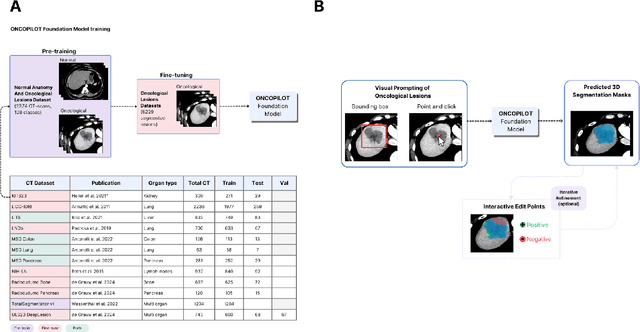
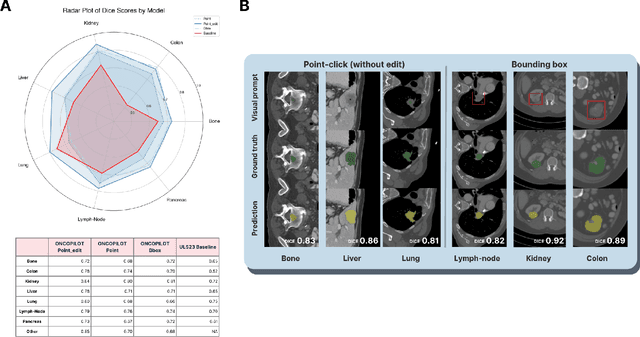

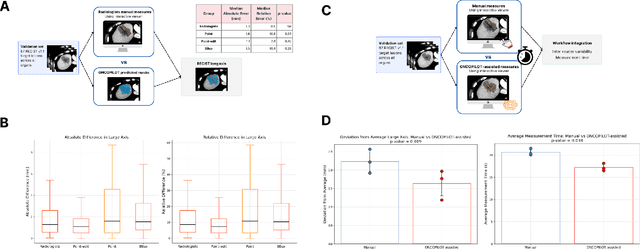
Abstract:Carcinogenesis is a proteiform phenomenon, with tumors emerging in various locations and displaying complex, diverse shapes. At the crucial intersection of research and clinical practice, it demands precise and flexible assessment. However, current biomarkers, such as RECIST 1.1's long and short axis measurements, fall short of capturing this complexity, offering an approximate estimate of tumor burden and a simplistic representation of a more intricate process. Additionally, existing supervised AI models face challenges in addressing the variability in tumor presentations, limiting their clinical utility. These limitations arise from the scarcity of annotations and the models' focus on narrowly defined tasks. To address these challenges, we developed ONCOPILOT, an interactive radiological foundation model trained on approximately 7,500 CT scans covering the whole body, from both normal anatomy and a wide range of oncological cases. ONCOPILOT performs 3D tumor segmentation using visual prompts like point-click and bounding boxes, outperforming state-of-the-art models (e.g., nnUnet) and achieving radiologist-level accuracy in RECIST 1.1 measurements. The key advantage of this foundation model is its ability to surpass state-of-the-art performance while keeping the radiologist in the loop, a capability that previous models could not achieve. When radiologists interactively refine the segmentations, accuracy improves further. ONCOPILOT also accelerates measurement processes and reduces inter-reader variability, facilitating volumetric analysis and unlocking new biomarkers for deeper insights. This AI assistant is expected to enhance the precision of RECIST 1.1 measurements, unlock the potential of volumetric biomarkers, and improve patient stratification and clinical care, while seamlessly integrating into the radiological workflow.
Efficient Medical Question Answering with Knowledge-Augmented Question Generation
May 23, 2024Abstract:In the expanding field of language model applications, medical knowledge representation remains a significant challenge due to the specialized nature of the domain. Large language models, such as GPT-4, obtain reasonable scores on medical question answering tasks, but smaller models are far behind. In this work, we introduce a method to improve the proficiency of a small language model in the medical domain by employing a two-fold approach. We first fine-tune the model on a corpus of medical textbooks. Then, we use GPT-4 to generate questions similar to the downstream task, prompted with textbook knowledge, and use them to fine-tune the model. Additionally, we introduce ECN-QA, a novel medical question answering dataset containing ``progressive questions'' composed of related sequential questions. We show the benefits of our training strategy on this dataset. The study's findings highlight the potential of small language models in the medical domain when appropriately fine-tuned. The code and weights are available at https://github.com/raidium-med/MQG.
Beyond Task Performance: Evaluating and Reducing the Flaws of Large Multimodal Models with In-Context Learning
Oct 01, 2023Abstract:Following the success of Large Language Models (LLMs), Large Multimodal Models (LMMs), such as the Flamingo model and its subsequent competitors, have started to emerge as natural steps towards generalist agents. However, interacting with recent LMMs reveals major limitations that are hardly captured by the current evaluation benchmarks. Indeed, task performances (e.g., VQA accuracy) alone do not provide enough clues to understand their real capabilities, limitations, and to which extent such models are aligned to human expectations. To refine our understanding of those flaws, we deviate from the current evaluation paradigm and propose the EvALign-ICL framework, in which we (1) evaluate 8 recent open-source LMMs (based on the Flamingo architecture such as OpenFlamingo and IDEFICS) on 5 different axes; hallucinations, abstention, compositionality, explainability and instruction following. Our evaluation on these axes reveals major flaws in LMMs. To efficiently address these problems, and inspired by the success of in-context learning (ICL) in LLMs, (2) we explore ICL as a solution and study how it affects these limitations. Based on our ICL study, (3) we push ICL further and propose new multimodal ICL approaches such as; Multitask-ICL, Chain-of-Hindsight-ICL, and Self-Correcting-ICL. Our findings are as follows; (1) Despite their success, LMMs have flaws that remain unsolved with scaling alone. (2) The effect of ICL on LMMs flaws is nuanced; despite its effectiveness for improved explainability, abstention, and instruction following, ICL does not improve compositional abilities, and actually even amplifies hallucinations. (3) The proposed ICL variants are promising as post-hoc approaches to efficiently tackle some of those flaws. The code is available here: https://evalign-icl.github.io/
Unified Model for Image, Video, Audio and Language Tasks
Jul 30, 2023Abstract:Large Language Models (LLMs) have made the ambitious quest for generalist agents significantly far from being a fantasy. A key hurdle for building such general models is the diversity and heterogeneity of tasks and modalities. A promising solution is unification, allowing the support of a myriad of tasks and modalities within one unified framework. While few large models (e.g., Flamingo (Alayrac et al., 2022), trained on massive datasets, can support more than two modalities, current small to mid-scale unified models are still limited to 2 modalities, usually image-text or video-text. The question that we ask is: is it possible to build efficiently a unified model that can support all modalities? To answer this, we propose UnIVAL, a step further towards this ambitious goal. Without relying on fancy datasets sizes or models with billions of parameters, the ~ 0.25B parameter UnIVAL model goes beyond two modalities and unifies text, images, video, and audio into a single model. Our model is efficiently pretrained on many tasks, based on task balancing and multimodal curriculum learning. UnIVAL shows competitive performance to existing state-of-the-art approaches, across image and video-text tasks. The feature representations learned from image and video-text modalities, allows the model to achieve competitive performance when finetuned on audio-text tasks, despite not being pretrained on audio. Thanks to the unified model, we propose a novel study on multimodal model merging via weight interpolation of models trained on different multimodal tasks, showing their benefits in particular for out-of-distribution generalization. Finally, we motivate unification by showing the synergy between tasks. The model weights and code are released here: https://github.com/mshukor/UnIVAL.
Improving Selective Visual Question Answering by Learning from Your Peers
Jun 14, 2023



Abstract:Despite advances in Visual Question Answering (VQA), the ability of models to assess their own correctness remains underexplored. Recent work has shown that VQA models, out-of-the-box, can have difficulties abstaining from answering when they are wrong. The option to abstain, also called Selective Prediction, is highly relevant when deploying systems to users who must trust the system's output (e.g., VQA assistants for users with visual impairments). For such scenarios, abstention can be especially important as users may provide out-of-distribution (OOD) or adversarial inputs that make incorrect answers more likely. In this work, we explore Selective VQA in both in-distribution (ID) and OOD scenarios, where models are presented with mixtures of ID and OOD data. The goal is to maximize the number of questions answered while minimizing the risk of error on those questions. We propose a simple yet effective Learning from Your Peers (LYP) approach for training multimodal selection functions for making abstention decisions. Our approach uses predictions from models trained on distinct subsets of the training data as targets for optimizing a Selective VQA model. It does not require additional manual labels or held-out data and provides a signal for identifying examples that are easy/difficult to generalize to. In our extensive evaluations, we show this benefits a number of models across different architectures and scales. Overall, for ID, we reach 32.92% in the selective prediction metric coverage at 1% risk of error (C@1%) which doubles the previous best coverage of 15.79% on this task. For mixed ID/OOD, using models' softmax confidences for abstention decisions performs very poorly, answering <5% of questions at 1% risk of error even when faced with only 10% OOD examples, but a learned selection function with LYP can increase that to 25.38% C@1%.
Rewarded soups: towards Pareto-optimal alignment by interpolating weights fine-tuned on diverse rewards
Jun 07, 2023



Abstract:Foundation models are first pre-trained on vast unsupervised datasets and then fine-tuned on labeled data. Reinforcement learning, notably from human feedback (RLHF), can further align the network with the intended usage. Yet the imperfections in the proxy reward may hinder the training and lead to suboptimal results; the diversity of objectives in real-world tasks and human opinions exacerbate the issue. This paper proposes embracing the heterogeneity of diverse rewards by following a multi-policy strategy. Rather than focusing on a single a priori reward, we aim for Pareto-optimal generalization across the entire space of preferences. To this end, we propose rewarded soup, first specializing multiple networks independently (one for each proxy reward) and then interpolating their weights linearly. This succeeds empirically because we show that the weights remain linearly connected when fine-tuned on diverse rewards from a shared pre-trained initialization. We demonstrate the effectiveness of our approach for text-to-text (summarization, Q&A, helpful assistant, review), text-image (image captioning, text-to-image generation, visual grounding, VQA), and control (locomotion) tasks. We hope to enhance the alignment of deep models, and how they interact with the world in all its diversity.
eP-ALM: Efficient Perceptual Augmentation of Language Models
Mar 20, 2023Abstract:Large Language Models (LLMs) have so far impressed the world, with unprecedented capabilities that emerge in models at large scales. On the vision side, transformer models (i.e., ViT) are following the same trend, achieving the best performance on challenging benchmarks. With the abundance of such unimodal models, a natural question arises; do we need also to follow this trend to tackle multimodal tasks? In this work, we propose to rather direct effort to efficient adaptations of existing models, and propose to augment Language Models with perception. Existing approaches for adapting pretrained models for vision-language tasks still rely on several key components that hinder their efficiency. In particular, they still train a large number of parameters, rely on large multimodal pretraining, use encoders (e.g., CLIP) trained on huge image-text datasets, and add significant inference overhead. In addition, most of these approaches have focused on Zero-Shot and In Context Learning, with little to no effort on direct finetuning. We investigate the minimal computational effort needed to adapt unimodal models for multimodal tasks and propose a new challenging setup, alongside different approaches, that efficiently adapts unimodal pretrained models. We show that by freezing more than 99\% of total parameters, training only one linear projection layer, and prepending only one trainable token, our approach (dubbed eP-ALM) significantly outperforms other baselines on VQA and Captioning across Image, Video, and Audio modalities, following the proposed setup. The code will be available here: https://github.com/mshukor/eP-ALM.
Dynamic Query Selection for Fast Visual Perceiver
May 22, 2022
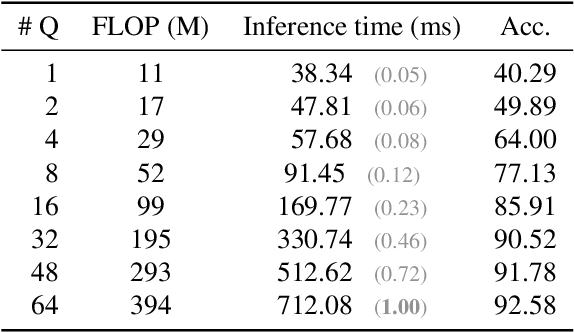
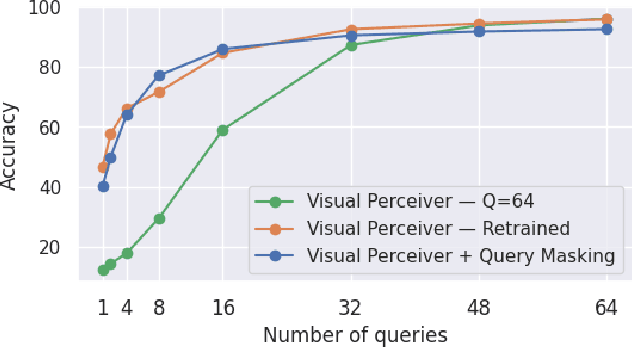
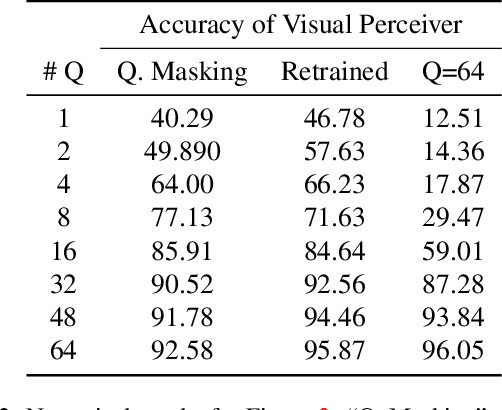
Abstract:Transformers have been matching deep convolutional networks for vision architectures in recent works. Most work is focused on getting the best results on large-scale benchmarks, and scaling laws seem to be the most successful strategy: bigger models, more data, and longer training result in higher performance. However, the reduction of network complexity and inference time remains under-explored. The Perceiver model offers a solution to this problem: by first performing a Cross-attention with a fixed number Q of latent query tokens, the complexity of the L-layers Transformer network that follows is bounded by O(LQ^2). In this work, we explore how to make Perceivers even more efficient, by reducing the number of queries Q during inference while limiting the accuracy drop.
 Add to Chrome
Add to Chrome Add to Firefox
Add to Firefox Add to Edge
Add to Edge